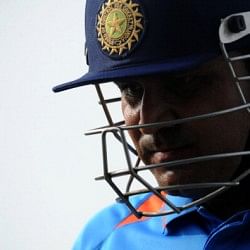
Goodbye Viru, thank you for the entertainment!

Virender Sehwag
For any cricketing demigod in India, it is near impossible to determine the right time to exit the arena. Few in the recent past have managed that feat, while others have ingloriously failed trying. After all, who can forget Rahul Dravid getting repeatedly bowled in Australia and being a pale shadow of his former self? Who can forget Kapil Dev delaying his imminent departure in order to achieve that ever-escaping last hurrah?
For Virender Sehwag, it is a similar juncture. He is at the crossroads of his career, where he needs to determine what exactly he wants to extract from his cricketing future. He isn’t getting younger; the reflexes and the hand-eye coordination we marvelled at aren’t there any more. He is unsure of where he wants to bat, and there is a bunch of exceptional young cricketers who are making their presence felt in the Indian line-up. In such a scenario, the most obvious question that lingers in the air is: does he want to play, or does he believe he can play?
Supposedly, in a conversation with Vivian Richards during the Indian Premier League 2013, Sehwag had admitted that he badly wanted to make his way back to the Indian team. But intent and actions are two completely different things.
News is doing rounds that on the eve of a Vijay Hazare Trophy match, Sehwag opted out because supposedly he did not want to open. Now if this is to be true, it’s an alarming reflection of the mindset of a cricketer who once reveled in tearing apart the opposition’s bowling. As a matter of fact, Sehwag was never known for his footwork or exceptional technique; it was his positive attitude that made him one of the most feared batsmen of his era. If that attitude is now missing, will the intent culminate into actions?
The problem that Sehwag faces is something Sourav Ganguly faced when he made a comeback into the Indian team in 2006: their age against them. Any investment in a Rohit Sharma or a Shikhar Dhawan at present is going to reap dividends over a longer period of time than what would be derived out of giving Sehwag a second go. At the same time, in order to promote meritocracy, it is imperative that performing youngsters don’t get done away with for vague notions of ‘experience’. An additional problem that Sehwag has burdened himself with, is his reluctance to open the innings. Former captains and cricket pundits have all shared the common view that what defined Sehwag was the aggression he displayed while opening the batting, and, if he wants to have any scope of coming back, he should stick with the tried and tested path. It is interesting to note that in both these fronts, Ganguly got a fairer deal: there wasn’t a clear replacement for Ganguly at No. 6 and the left-hander was open to the idea of being played anywhere in the batting-order.
Even if one is to assume that experience is something the selectors need to factor in before important tours to England and Australia, Sehwag, unlike his opening partner Gautam Gambhir, has done nothing to set the domestic circuit ablaze. A customary look at Sehwag’s scores will indicate his ineffectiveness: 10, 15, 32, 11, 10 and 12. All these runs were scored while playing for Delhi in both formats at No. 3 or No. 4. If one takes it back further, there is just one half-century in the entire Ranji season that he can boast off, against a lowly Vidarbha. And it was exactly such numbers, albeit in the International arena, that led to Sehwag being dropped. Since January 1st, 2011, Sehwag’s average has been tottering at 28 (almost half his career average) in Test cricket, with just a solitary century to his name. During the same period in ODIs, barring the magnificent 219 at Indore, he has averaged around 30 with just three scores above 50.
In no way do I intend to write off a player as great as Virender Sehwag. Only few can match his class on any given day, and, if fate has its say, Viru might make me eat up my words soon. However, the skeptic in me can see the writing on the wall. The same man who bludgeoned his way to almost three triple centuries in Test cricket, who took on the best of attacks at places like Melbourne, Adelaide and Bloemfontein and has as many as 38 international centuries, is now failing against mediocre bowling line-ups in conditions that used to be his bread and butter.
The bespectacled Viru is a crude example of how things change in sports and how permanency is ever-eluding for athletes from across fields. And keeping all this in mind, it is time that Sehwag walks into the sunset, for there is very little that he hasn’t achieved. The further he prolongs his departure, the more excruciatingly painful will it be for his fans over the world. It is time that we quietly gesture to him: ‘Goodbye Viru, thank you for the entertainment!’